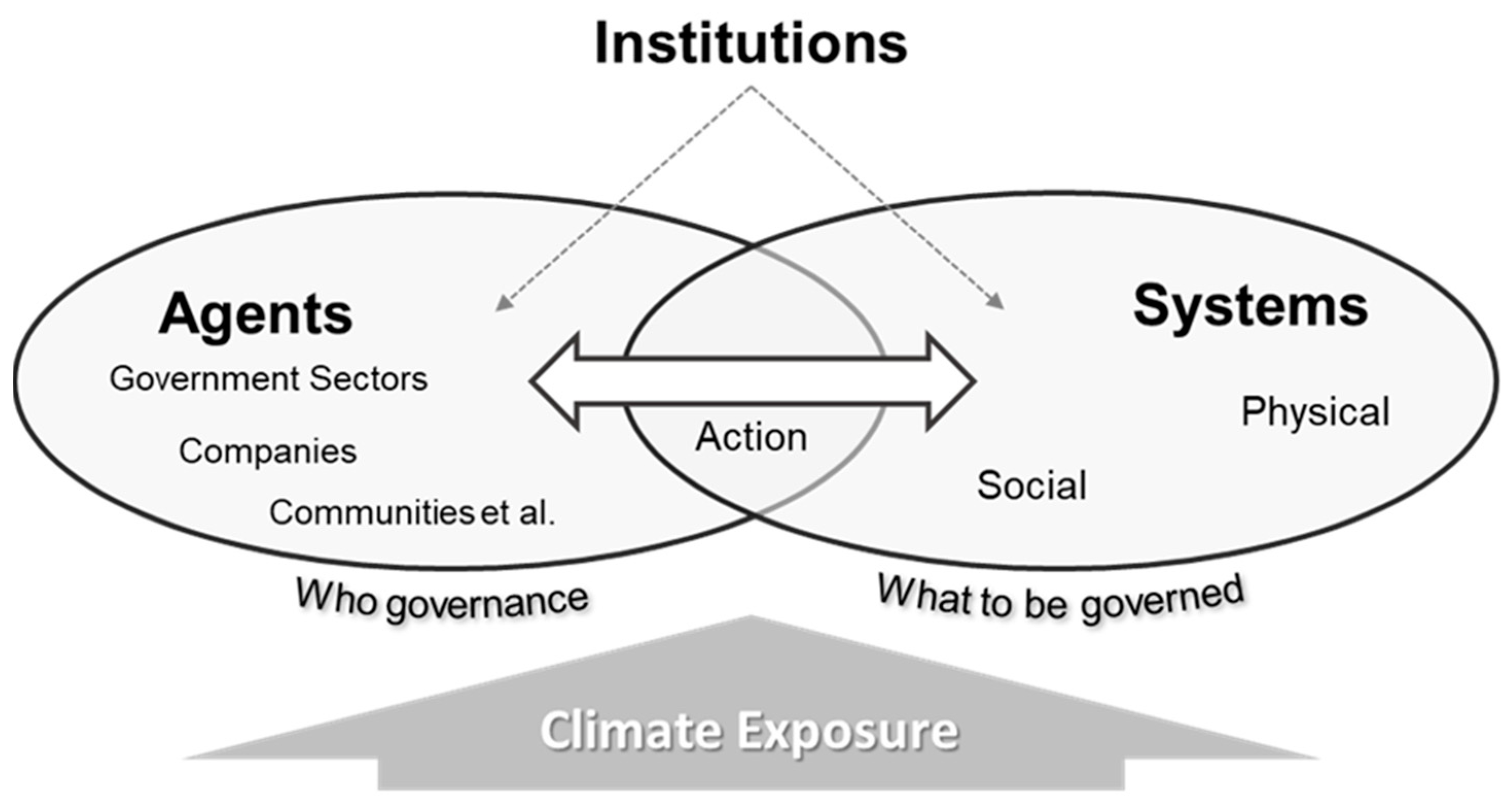Governing Urban Climate Resilience (UCR): Systems, Agents, and Institutions in Shanghai, China
Abstract
1. Introduction
- Where do climate shocks and pressures manifest in urban systems?
- Who is involved in coping with climate resilience planning and policy?
- In what way are the urban resilience elements organized in the context of climate resilience?
2. Theoretical Bias and Analysis Dimensions
2.1. Components and Principles of UCR
2.2. Framework for UCR Governance
3. Study Area: Shanghai, China
4. Materials and Methods
4.1. Document Selection: Planning and Policy
4.2. Mixed Methods: Textual Analysis and Semi-Structured Interviews
5. Results
5.1. Climate Shocks and Pressures
5.1.1. Flooding
5.1.2. Extreme Heat
5.2. Elements of Governance
5.2.1. Systems: Critical Functions Keep Running
5.2.2. Agents: Leading Sectors Organize Actions
5.2.3. Institutions: Distinctions between Risks
6. Discussion
6.1. Flooding and Extreme Heat: Identify Processes and Characteristics of Different Risk Types
6.2. Systems and Agents: Clarify Departmental Responsibilities and Empower Self-Governance
6.3. Planning and Policy: Discover Opportunities for Urban Planning
6.4. Limitations
7. Conclusions
Author Contributions
Funding
Institutional Review Board Statement
Informed Consent Statement
Data Availability Statement
Acknowledgments
Conflicts of Interest
Appendix A
| Plan Type | Plan Name | Year |
|---|---|---|
| comprehensive plan | Shanghai City Comprehensive Plan (2017–2035) | 2018 |
| Yangtze River Delta Ecological Green Integrated Development Demonstration Zone Land and Space Comprehensive Plan (2021–2035) | 2023 | |
| specialized plan | Shanghai Metropolitan Area Collaborative Space Planning (2035–2050) | 2022 |
| Shanghai Comprehensive Disaster Prevention and Reduction Plan (2022–2035) | 2022 | |
| Shanghai Sponge City Special Planning (2016–2035) | 2016 | |
| Shanghai Flood Control and Waterlogging Planning (2020–2035) | 2021 | |
| Shanghai Urban Rainwater Drainage Planning (2020–2035) | 2020 | |
| Special planning for slow traffic space connection in the outer ring green belt and areas along the line | 2022 | |
| Special planning for dikes and ecological landscapes on both sides of the Huangpu River (middle and upper reaches) | 2022 | |
| construction plan | Construction plan for areas along the Huangpu River (2018–2035) | 2020 |
| Construction planning for areas along the Suzhou River (2018–2035) | 2020 | |
| Sponge City construction planning for different administrative districts in Shanghai | - |
| Policy Type | Policy Subtype | Policy Name | Year |
|---|---|---|---|
| guiding policy | 14th five-year plan | Shanghai’s “14th Five-Year Plan” for Water System Management | 2021 |
| Shanghai’s Marine “14th Five-Year Plan” | 2021 | ||
| Shanghai Meteorological Service Guarantee “14th Five-Year Plan” | 2021 | ||
| Shanghai Emergency Management “14th Five-Year Plan” | 2021 | ||
| Shanghai’s “14th Five-Year Plan” for the development of “Huangpu River” and “Suzhou River” | 2021 | ||
| Shanghai’s “14th Five-Year Plan” for ecological and environmental protection | 2021 | ||
| implementation/action plan | Smart Water and Marine Three-Year Action Plan (2022–2024) | 2022 | |
| Shanghai’s three-year action plan for ecological environment protection and construction from 2021 to 2023 | 2021 | ||
| Shanghai’s “14th Five-Year Plan” Urban Drainage and Flood Prevention System Construction Action Plan | 2022 | ||
| Shanghai Carbon Peak Implementation Plan | 2022 | ||
| Shanghai Action Plan for Adapting to Climate Change (2023–2035) | 2023 | ||
| emergency plan | Shanghai Water Affairs Bureau Flood and Drought Disaster Prevention Emergency Plan | 2022 | |
| legal policy | government directive | Shanghai Meteorological Disaster Prevention Measures | 2022 |
Appendix B
| No. | Questions |
|---|---|
| 1. | What do you think does Shanghai face the main types of climate risks? Any representative examples? Any representative examples? |
| 2. | What is your role in managing climate risks? |
| 3. | Which government agencies or other organizations are involved in the governance of climate risks? |
| 4. | What climate disaster events in Shanghai have deeply impacted you in the past five years? |
| 5. | Do you know which groups in Shanghai are adversely affected by climate disaster events? |
| 6. | What is the current model or process for managing climate risks in Shanghai? |
| 7. | In your opinion, what are the main barriers to enhancing climate resilience in Shanghai? |
| 8. | Can you share your organization’s experiences facing climate risks in Shanghai? |
| 9. | Do you have any good suggestions for enhancing climate resilience in Shanghai? |
References
- Birchall, S.J.; Bonnett, N. Climate Change Adaptation Policy and Practice: The Role of Agents, Institutions and Systems. Cities 2021, 108, 103001. [Google Scholar] [CrossRef]
- IPCC. Climate Change 2021: The Physical Science Basis: Working Group I Contribution to the Sixth Assessment Report of the Intergovernmental Panel on Climate Change; Cambridge University Press: Cambridge, UK, 2023. [Google Scholar]
- Kelman, I.; Gaillard, J.-C.; Mercer, J. Climate Change’s Role in Disaster Risk Reduction’s Future: Beyond Vulnerability and Resilience. Int. J. Disaster Risk Sci. 2015, 6, 21–27. [Google Scholar] [CrossRef]
- Baeumler, A.; Ijjasz-Vasquez, E.; Mehndiratta, S. Sustainable Low-Carbon City Development in China; World Bank Publications: Washington, DC, USA, 2012; ISBN 978-0-8213-8987-4. [Google Scholar]
- Kumar, P. Climate Change and Cities: Challenges Ahead. Front. Sustain. Cities 2021, 3, 645613. [Google Scholar] [CrossRef]
- IPCC. Climate Change 2022: Impacts, Adaptation and Vulnerability; Contribution of Working Group II to the Sixth Assessment Report of the Intergovernmental Panel on Climate Change; Cambridge University Press: Cambridge, UK, 2022. [Google Scholar]
- He, B.-J.; Wang, J.; Zhu, J.; Qi, J. Beating the Urban Heat: Situation, Background, Impacts and the Way Forward in China. Renew. Sustain. Energy Rev. 2022, 161, 112350. [Google Scholar] [CrossRef]
- Castán Broto, V.; Westman, L.K. Ten Years after Copenhagen: Reimagining Climate Change Governance in Urban Areas. Wiley Interdiscip. Rev. Clim. Chang. 2020, 11, e643. [Google Scholar] [CrossRef]
- Bellinson, R.; Chu, E. Learning Pathways and the Governance of Innovations in Urban Climate Change Resilience and Adaptation. J. Environ. Policy Plan. 2019, 21, 76–89. [Google Scholar] [CrossRef]
- Bulkeley, H. Cities and the Governing of Climate Change. Annu. Rev. Environ. Resour. 2010, 35, 229–253. [Google Scholar] [CrossRef]
- Bulkeley, H. Cities and Climate Change; Routledge: New York, NY, USA, 2013; ISBN 0-203-07720-2. [Google Scholar]
- Shaw, R.; Team, I. Climate Disaster Resilience: Focus on Coastal Urban Cities in Asia. Asian J. Environ. Disaster Manag. 2009, 1, 101–116. [Google Scholar]
- Du, T.L.T.; Bui, D.D.; Buurman, J.; Quach, X.T. Towards Adaptive Governance for Urban Drought Resilience: The Case of Da Nang, Vietnam. Int. J. Water Resour. Dev. 2018, 34, 597–615. [Google Scholar] [CrossRef]
- Holling, C.S. Adaptive Environmental Assessment and Management; John Wiley & Sons: Hoboken, NJ, USA, 1978; ISBN 978-1-932846-07-2. [Google Scholar]
- Fuhr, H.; Hickmann, T.; Kern, K. The Role of Cities in Multi-Level Climate Governance: Local Climate Policies and the 1.5 °C Target. Curr. Opin. Environ. Sustain. 2018, 30, 1–6. [Google Scholar] [CrossRef]
- Shi, L.; Chu, E.; Debats, J. Explaining Progress in Climate Adaptation Planning across 156 US Municipalities. J. Am. Plan. Assoc. 2015, 81, 191–202. [Google Scholar] [CrossRef]
- Amundsen, H.; Berglund, F.; Westskog, H. Overcoming Barriers to Climate Change Adaptation—A Question of Multilevel Governance? Environ. Plan. C Gov. Policy 2010, 28, 276–289. [Google Scholar] [CrossRef]
- Aylett, A. Progress and Challenges in the Urban Governance of Climate Change: Results of a Global Survey; MIT: Cambridge, MA, USA, 2014. [Google Scholar]
- Francesch-Huidobro, M.; Dabrowski, M.; Tai, Y.; Chan, F.; Stead, D. Governance Challenges of Flood-Prone Delta Cities: Integrating Flood Risk Management and Climate Change in Spatial Planning. Prog. Plan. 2017, 114, 1–27. [Google Scholar] [CrossRef]
- Rana, I.A.; Asim, M.; Aslam, A.B.; Jamshed, A. Disaster Management Cycle and Its Application for Flood Risk Reduction in Urban Areas of Pakistan. Urban Clim. 2021, 38, 100893. [Google Scholar] [CrossRef]
- Razafindrabe, B.H.N.; Kada, R.; Arima, M.; Inoue, S. Analyzing Flood Risk and Related Impacts to Urban Communities in Central Vietnam. Mitig. Adapt. Strateg. Glob. Chang. 2014, 19, 177–198. [Google Scholar] [CrossRef]
- Vojinovic, Z.; Alves, A.; Gomez, J.P.; Weesakul, S.; Keerakamolchai, W.; Meesuk, V.; Sanchez, A. Effectiveness of Small- and Large-Scale Nature-Based Solutions for Flood Mitigation: The Case of Ayutthaya, Thailand. Sci. Total Environ. 2021, 789, 147725. [Google Scholar] [CrossRef]
- Keith, L.; Gabbe, C.J.; Schmidt, E. Urban Heat Governance: Examining the Role of Urban Planning. J. Environ. Policy Plan. 2023, 25, 642–662. [Google Scholar] [CrossRef]
- Meerow, S.; Keith, L. Planning for Extreme Heat. J. Am. Plan. Assoc. 2022, 88, 319–334. [Google Scholar] [CrossRef]
- Birchall, S.J.; MacDonald, S.; Baran, N.N. An Assessment of Systems, Agents, and Institutions in Building Community Resilience to Climate Change: A Case Study of Charlottetown, Canada. Urban Clim. 2022, 41, 101062. [Google Scholar] [CrossRef]
- Meerow, S.; Newell, J.P.; Stults, M. Defining Urban Resilience: A Review. Landsc. Urban Plan. 2016, 147, 38–49. [Google Scholar] [CrossRef]
- McGranahan, G.; Balk, D.; Anderson, B. The Rising Tide: Assessing the Risks of Climate Change and Human Settlements in Low Elevation Coastal Zones. Environ. Urban. 2007, 19, 17–37. [Google Scholar] [CrossRef]
- Statista Infographic: The World’s Next Megacities. Available online: https://www.statista.com/chart/29152/the-worlds-next-megacities (accessed on 1 July 2023).
- National Climate Center. China Blue Book on Climate Change (2022); Science Press: Beijing, China, 2022; ISBN 978-7-03-072789-3. [Google Scholar]
- SCC Shanghai’s Top 10 Weather and Climate Events for 2022 Released. Available online: https://weibo.com/ttarticle/p/show?id=2309404852867411607807 (accessed on 23 December 2023).
- SCC Top 10 Weather and Climate Events in Shanghai in 2021. Available online: https://sh.weather.com.cn/gdtp/01/3513177.shtml (accessed on 23 December 2023).
- Sharma, S.E. Urban Flood Resilience: Governing Conflicting Urbanism and Climate Action in Amsterdam. Rev. Int. Polit. Econ. 2023, 30, 1413–1435. [Google Scholar] [CrossRef]
- Zaidi, R.Z.; Pelling, M. Institutionally Configured Risk: Assessing Urban Resilience and Disaster Risk Reduction to Heat Wave Risk in London. Urban Stud. 2015, 52, 1218–1233. [Google Scholar] [CrossRef]
- Muñoz-Erickson, T.A.; Meerow, S.; Hobbins, R.; Cook, E.; Iwaniec, D.M.; Berbés-Blázquez, M.; Grimm, N.B.; Barnett, A.; Cordero, J.; Gim, C.; et al. Beyond Bouncing Back? Comparing and Contesting Urban Resilience Frames in US and Latin American Contexts. Landsc. Urban Plan. 2021, 214, 104173. [Google Scholar] [CrossRef]
- Holling, C.S. Resilience and Stability of Ecological Systems. Annu. Rev. Ecol. Syst. 1973, 4, 1–23. [Google Scholar] [CrossRef]
- Davoudi, S.; Shaw, K.; Haider, L.J.; Quinlan, A.E.; Peterson, G.D.; Wilkinson, C.; Fünfgeld, H.; McEvoy, D.; Porter, L.; Davoudi, S. Resilience: A Bridging Concept or a Dead End? “Reframing” Resilience: Challenges for Planning Theory and Practice Interacting Traps: Resilience Assessment of a Pasture Management System in Northern Afghanistan Urban Resilience: What Does It Mean in Planning Practice? Resilience as a Useful Concept for Climate Change Adaptation? The Politics of Resilience for Planning: A Cautionary Note. Plan. Theory Pract. 2012, 13, 299–333. [Google Scholar] [CrossRef]
- Folke, C. Resilience: The Emergence of a Perspective for Social—Ecological Systems Analyses. Glob. Environ. Chang. 2006, 16, 253–267. [Google Scholar] [CrossRef]
- Lambrou, N.; Loukaitou-Sideris, A. Resilience Plans in the US: An Evaluation. J. Environ. Plan. Manag. 2022, 65, 809–832. [Google Scholar] [CrossRef]
- UN. The New Urban Agenda; United Nations: New York, NY, USA, 2016. [Google Scholar]
- Sharifi, A. Resilience of Urban Social-Ecological-Technological Systems (SETS): A Review. Sustain. Cities Soc. 2023, 99, 104910. [Google Scholar] [CrossRef]
- Cui, Y.; Yin, M.; Cheng, X.; Tang, J.; He, B.-J. Towards Cool Cities and Communities: Preparing for an Increasingly Hot Future by the Development of Heat-Resilient Infrastructure and Urban Heat Management Plan. Environ. Technol. Innov. 2024, 34, 103568. [Google Scholar] [CrossRef]
- US GAO. CLIMATE CHANGE—Selected Governments Have Approached Adaptation through Laws and Long-Term Plans; 2016. Available online: https://www.gao.gov/assets/gao-16-454.pdf (accessed on 3 February 2024).
- Begum, R.A.; Sarkar, M.S.K.; Jaafar, A.H.; Pereira, J.J. Toward Conceptual Frameworks for Linking Disaster Risk Reduction and Climate Change Adaptation. Int. J. Disaster Risk Reduct. 2014, 10, 362–373. [Google Scholar] [CrossRef]
- Birkmann, J.; von Teichman, K. Integrating Disaster Risk Reduction and Climate Change Adaptation: Key Challenges-Scales, Knowledge, and Norms. Sustain. Sci. 2010, 5, 171–184. [Google Scholar] [CrossRef]
- Clegg, G. Integration of CCA and DRR for Flood Resilience: A Review of Good Practices in the United Kingdom; Global Assessment Report on Disaster Risk Reduction. 2019. Available online: https://www.undrr.org/publication/integration-cca-and-drr-flood-resilience-review-good-practices-united-kingdom (accessed on 3 February 2024).
- Meerow, S.; Stults, M. Comparing Conceptualizations of Urban Climate Resilience in Theory and Practice. Sustainability 2016, 8, 701. [Google Scholar] [CrossRef]
- Pazhuhan (Panahandeh Khah), M. Institutionalizing Urban Climate Governance in the Global South? Evidence from Tehran Urban Management, Iran. Clim. Dev. 2023, 15, 793–807. [Google Scholar] [CrossRef]
- Liu, M.; Lo, K. A Comparative Review of Urban Climate Governance in Chinese and Western Contexts. Urban Gov. 2021, 1, 81–88. [Google Scholar] [CrossRef]
- Carmin, J.; Anguelovski, I.; Roberts, D. Urban Climate Adaptation in the Global South: Planning in an Emerging Policy Domain. J. Plan. Educ. Res. 2012, 32, 18–32. [Google Scholar] [CrossRef]
- Tanner, T.; Mitchell, T.; Polack, E.; Guenther, B. Urban Governance for Adaptation: Assessing Climate Change Resilience in Ten Asian Cities. IDS Work. Pap. 2009, 2009, 1–47. [Google Scholar] [CrossRef]
- Tyler, S.; Moench, M. A Framework for Urban Climate Resilience. Clim. Dev. 2012, 4, 311–326. [Google Scholar] [CrossRef]
- Cinner, J.E.; Barnes, M.L. Social Dimensions of Resilience in Social-Ecological Systems. One Earth 2019, 1, 51–56. [Google Scholar] [CrossRef]
- Feng, L.; Wu, Q.; Wu, W.; Liao, W. Decision-Maker-Oriented VS. Collaboration: China’s Public Participation in Environmental Decision-Making. Sustainability 2020, 12, 1334. [Google Scholar] [CrossRef]
- Meng, M.; Dąbrowski, M.; Stead, D. Shifts in Spatial Plans for Flood Resilience and Climate Adaptation: Examining Planning Procedure and Planning Mandates. Sustainability 2020, 12, 105. [Google Scholar] [CrossRef]
- Wu, F. The Global and Local Dimensions of Place-Making: Remaking Shanghai as a World City. Urban Stud. 2000, 37, 1359–1377. [Google Scholar] [CrossRef]
- SMSB. Shanghai Statistical Yearbook; China Statistics Press, Shanghai Municipal Statistics Bureau: Shanghai, China, 2022. [Google Scholar]
- Shanghai Hongkou District People’s Government What Is the Permanent Population of Shanghai in 2022? What Proportion Are Aged 60 and above? Data Is Coming. Available online: https://www.shhk.gov.cn/xwzx/002008/002008040/20230329/eed52d58-9646-4551-8ed1-dc53944b5882.html (accessed on 20 November 2023).
- He, B.-J.; Wang, J.; Liu, H.; Ulpiani, G. Localized Synergies between Heat Waves and Urban Heat Islands: Implications on Human Thermal Comfort and Urban Heat Management. Environ. Res. 2021, 193, 110584. [Google Scholar] [CrossRef] [PubMed]
- SMPG Shanghai. Available online: https://www.gov.cn/test/2005-08/10/content_21503.htm (accessed on 20 November 2023).
- NOAA National Centers for Environmental Information. Available online: https://www.ncei.noaa.gov/ (accessed on 20 December 2023).
- Zou, B. Increment Planning, Inventory Planning and Policy Planning. City Plan. Rev. 2013, 2, 35–37. [Google Scholar]
- Berrang-Ford, L.; Pearce, T.; Ford, J.D. Systematic Review Approaches for Climate Change Adaptation Research. Reg. Environ. Change 2015, 15, 755–769. [Google Scholar] [CrossRef]
- Brown, A.; Dayal, A.; Rumbaitis Del Rio, C. From Practice to Theory: Emerging Lessons from Asia for Building Urban Climate Change Resilience. Environ. Urban. 2012, 24, 531–556. [Google Scholar] [CrossRef]
- Chen, R.; Zhang, Y.; Xu, D.; Liu, M. Climate Change and Coastal Megacities: Disaster Risk Assessment and Responses in Shanghai City. In Climate Change, Extreme Events and Disaster Risk Reduction: Towards Sustainable Development Goals; Mal, S., Singh, R.B., Huggel, C., Eds.; Sustainable Development Goals Series; Springer International Publishing: Berlin/Heidelberg, Germany, 2018; pp. 203–216. ISBN 978-3-319-56469-2. [Google Scholar]
- Shi, J.; Cui, L.; Yang, H.; Sun, L. Spatial Pattern and Temporal Change of Climate in Shanghai. J. Geo-Inf. Sci. 2015, 17, 1348–1354. [Google Scholar]
- Ministry of Natural Resources. China Sea Level Bulletin; Ministry of Natural Resources: Beijing, China, 2023. [Google Scholar]
- Liu, M.; Wang, J.; Yin, J.; Quan, R.; Yu, B.; Tang, X.; Zhang, K.; Chen, R. Study on the Urban Safety and Comprehensive Disaster Prevention in Shanghai. Shanghai Urban Plan. Rev. 2016, 1, 1–8. [Google Scholar]
- SLRC. Shanghai Municipal Records: Meteorological Sub-Records (1978–2010); Shanghai Ren Min Chu Ban She: Shanghai, China, 2015; ISBN 978-7-208-17223-4. [Google Scholar]
- Liang, Z.; Tian, Z.; Sun, L.; Feng, K.; Zhong, H.; Gu, T.; Liu, X. Heat Wave, Electricity Rationing, and Trade-Offs between Environmental Gains and Economic Losses: The Example of Shanghai. Appl. Energy 2016, 184, 951–959. [Google Scholar] [CrossRef]
- Ma, W.; Xu, X.; Peng, L.; Kan, H. Impact of Extreme Temperature on Hospital Admission in Shanghai, China. Sci. Total Environ. 2011, 409, 3634–3637. [Google Scholar] [CrossRef] [PubMed]
- Tan, J.; Zheng, Y.; Tang, X.; Guo, C.; Li, L.; Song, G.; Zhen, X.; Yuan, D.; Kalkstein, A.J.; Li, F. The Urban Heat Island and Its Impact on Heat Waves and Human Health in Shanghai. Int. J. Biometeorol. 2010, 54, 75–84. [Google Scholar] [CrossRef] [PubMed]
- Bi, X.; Wu, C.; Wang, C.; Wang, Y.; Wang, X.; Song, C.; Li, J.; Fu, C. Impacts of Air Temperature and Its Extremes on Human Mortality in Shanghai, China. Urban Clim. 2022, 41, 101072. [Google Scholar] [CrossRef]
- Shanghai TV Shanghai: The Number of Emergency Room Patients Increases by 20% in Hot Weather. Doctors Remind You to Prevent Heat Stroke. Available online: https://service.shanghai.gov.cn/SHVideoJyh/videoshow_86E79159F4FED29F_0.html (accessed on 18 September 2023).
- Shanghai TV Shanghai: Electric Power Load Continues to Operate at High Levels, and the Power Department Increases the Frequency of Inspections. Available online: https://service.shanghai.gov.cn/SHVideoJyh/videoshow_4F2C269A259FA35C_0.html (accessed on 18 September 2023).
- Shanghai TV The Inflow of Water from the Yangtze River in Taihu Lake Is 30% Less than the Same Period Last Year, and the Water Level of the Huangpu River Is Now at the Lowest Level in the Same Period in 20 Years. Available online: https://service.shanghai.gov.cn/SHVideoJyh/videoshow_866B39A4BF18A76F_0.html (accessed on 18 September 2023).
- Zhang, Q.; Gemmer, M.; Chen, J. Climate Changes and Flood/Drought Risk in the Yangtze Delta, China, during the Past Millennium. Quat. Int. 2008, 176–177, 62–69. [Google Scholar] [CrossRef]
- Reckien, D.; Salvia, M.; Pietrapertosa, F.; Simoes, S.G.; Olazabal, M.; De Gregorio Hurtado, S.; Geneletti, D.; Krkoška Lorencová, E.; D’Alonzo, V.; Krook-Riekkola, A.; et al. Dedicated versus Mainstreaming Approaches in Local Climate Plans in Europe. Renew. Sustain. Energy Rev. 2019, 112, 948–959. [Google Scholar] [CrossRef]
- MHURD. Technical Guidelines for Sponge City Construction—Low Impact Development Stormwater System Construction (Trial); Ministry of Housing and Urban-Rural Development (MOHURD): Beijing, China, 2014. [Google Scholar]
- GOFSC. Guiding Opinions on Promoting the Construction of Sponge Cities; General Office of the State Council of the People′s Republic of China: Beijing, China, 2015. [Google Scholar]
- Dąbrowski, M.; Stead, D.; He, J.; Yu, F. Adaptive Capacity of the Pearl River Delta Cities in the Face of the Growing Flood Risk: Institutions, Ideas and Interests. Urban Stud. 2021, 58, 2683–2702. [Google Scholar] [CrossRef]
- Meng, M.; Dąbrowski, M.; Stead, D. Governing Resilience Planning: Organizational Structures, Institutional Rules, and Fiscal Incentives in Guangzhou. Land 2023, 12, 417. [Google Scholar] [CrossRef]
- Lixin, Y.; Lingling, G.; Dong, Z.; Junxue, Z.; Zhanwu, G. An Analysis on Disasters Management System in China. Nat. Hazards 2012, 60, 295–309. [Google Scholar] [CrossRef]
- Li, B.; Hu, B.; Liu, T.; Fang, L. Can Co-Production Be State-Led? Policy Pilots in Four Chinese Cities. Environ. Urban. 2019, 31, 249–266. [Google Scholar] [CrossRef]
- Fransen, J.; Peralta, D.O.; Vanelli, F.; Edelenbos, J.; Olvera, B.C. The Emergence of Urban Community Resilience Initiatives During the COVID-19 Pandemic: An International Exploratory Study. Eur. J. Dev. Res. 2022, 34, 432–454. [Google Scholar] [CrossRef]
- Liu, Z.; Lin, S.; Lu, T.; Shen, Y.; Liang, S. Towards a Constructed Order of Co-Governance: Understanding the State–Society Dynamics of Neighbourhood Collaborative Responses to COVID-19 in Urban China. Urban Stud. 2023, 60, 1730–1749. [Google Scholar] [CrossRef]
- Wu, F. Creating Chinese Urbanism: Urban Revolution and Governance Changes; UCL Press: London, UK, 2022. [Google Scholar]
- XNA NPC Approves State Council Institutional Reform Plan. Available online: https://www.gov.cn/guowuyuan/2018-03/17/content_5275116.htm (accessed on 21 December 2023).
- Meng, M. Spatial Planning for Urban Resilience in the Face of the Flood Risk: Institutional Actions, Opportunities and Challenges. A+ BE|Architect. Built Environ. 2021, 11, 1–296. [Google Scholar] [CrossRef]
- Labbé, J.; Ford, J.D.; Araos, M.; Flynn, M. The Government-Led Climate Change Adaptation Landscape in Nunavut, Canada. Environ. Rev. 2017, 25, 12–25. [Google Scholar] [CrossRef]
- Philipps, A.; Mrowczynski, R. Getting More out of Interviews. Understanding Interviewees’ Accounts in Relation to Their Frames of Orientation. Qual. Res. 2021, 21, 59–75. [Google Scholar] [CrossRef]
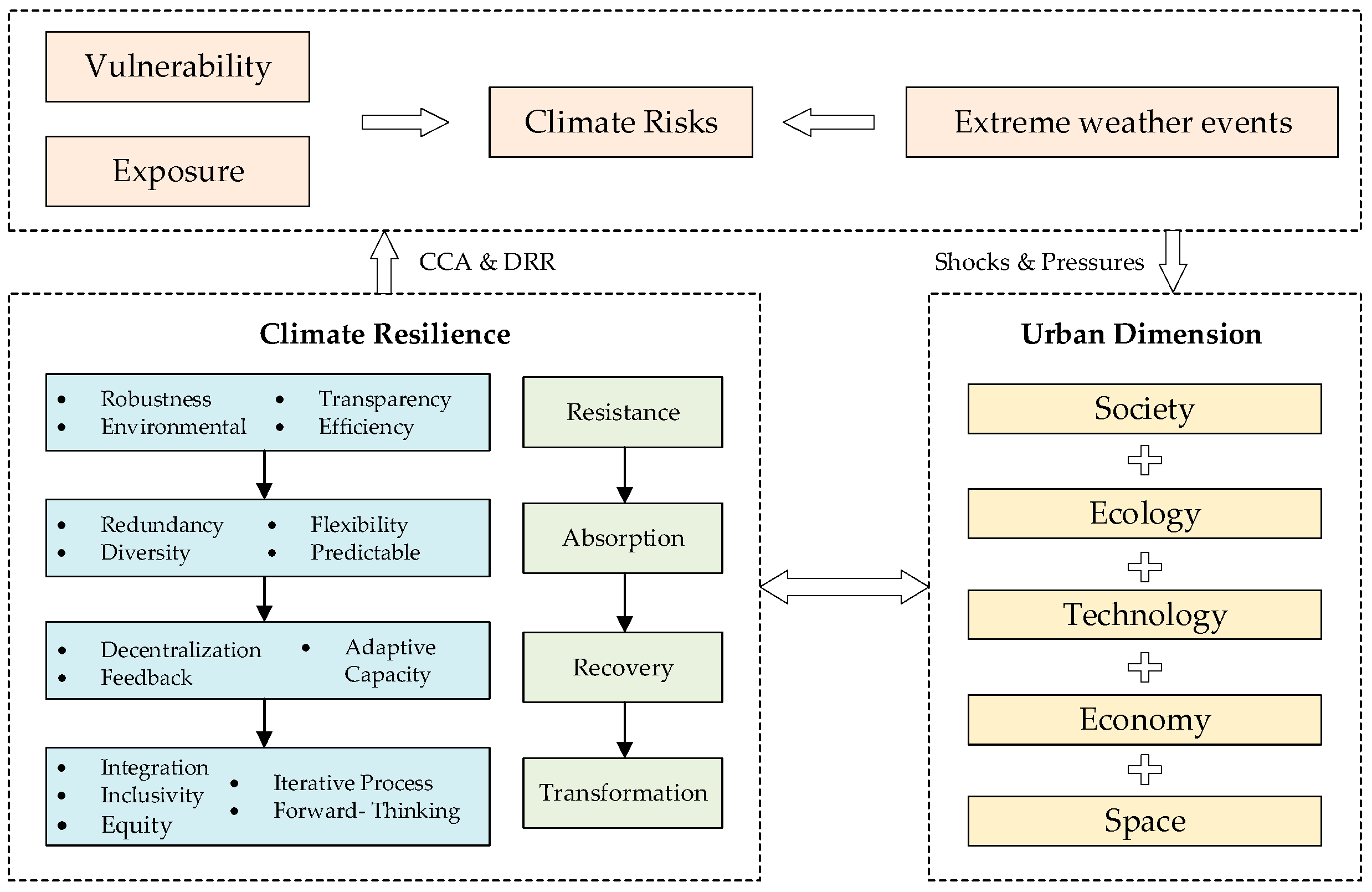
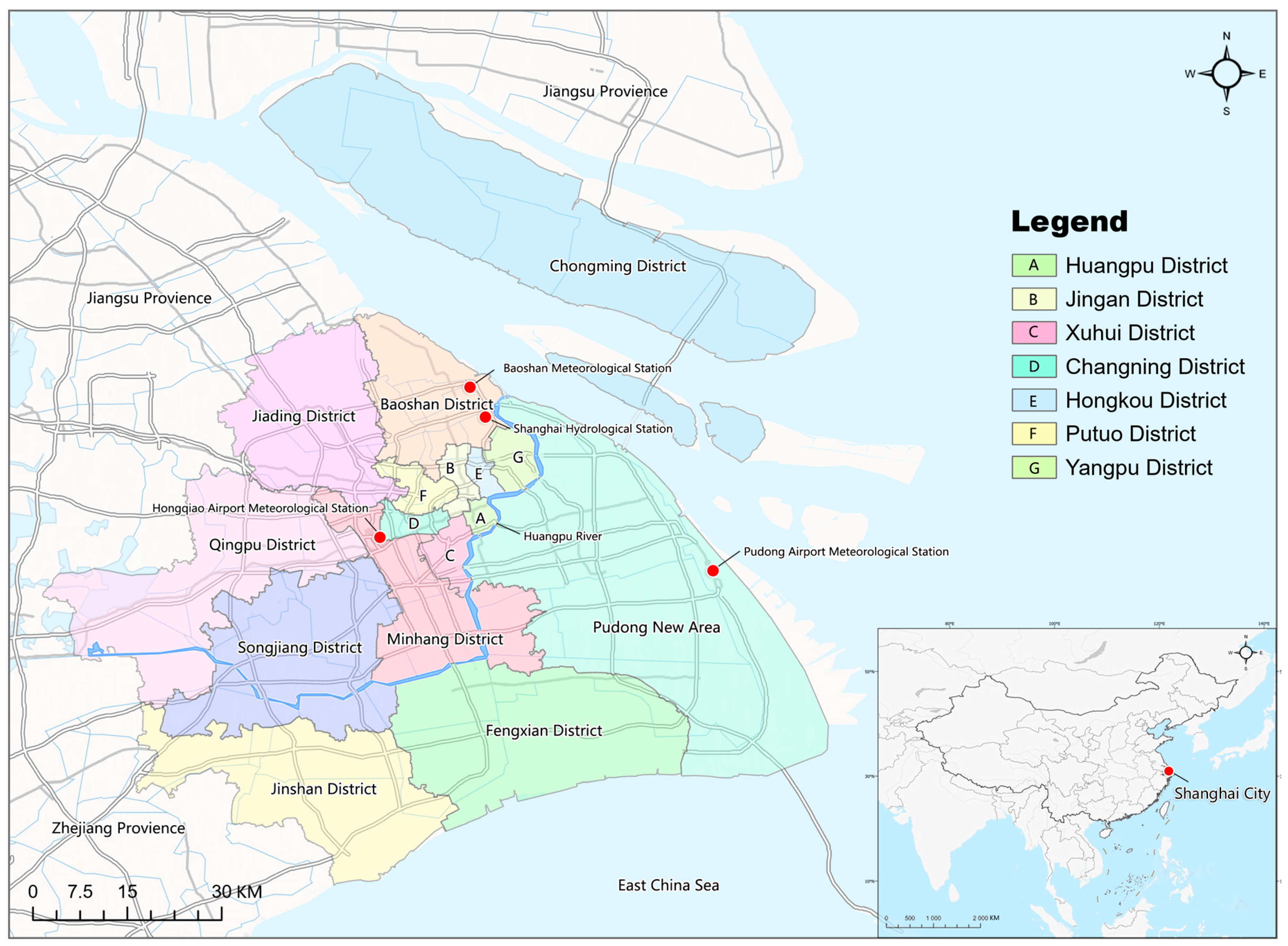
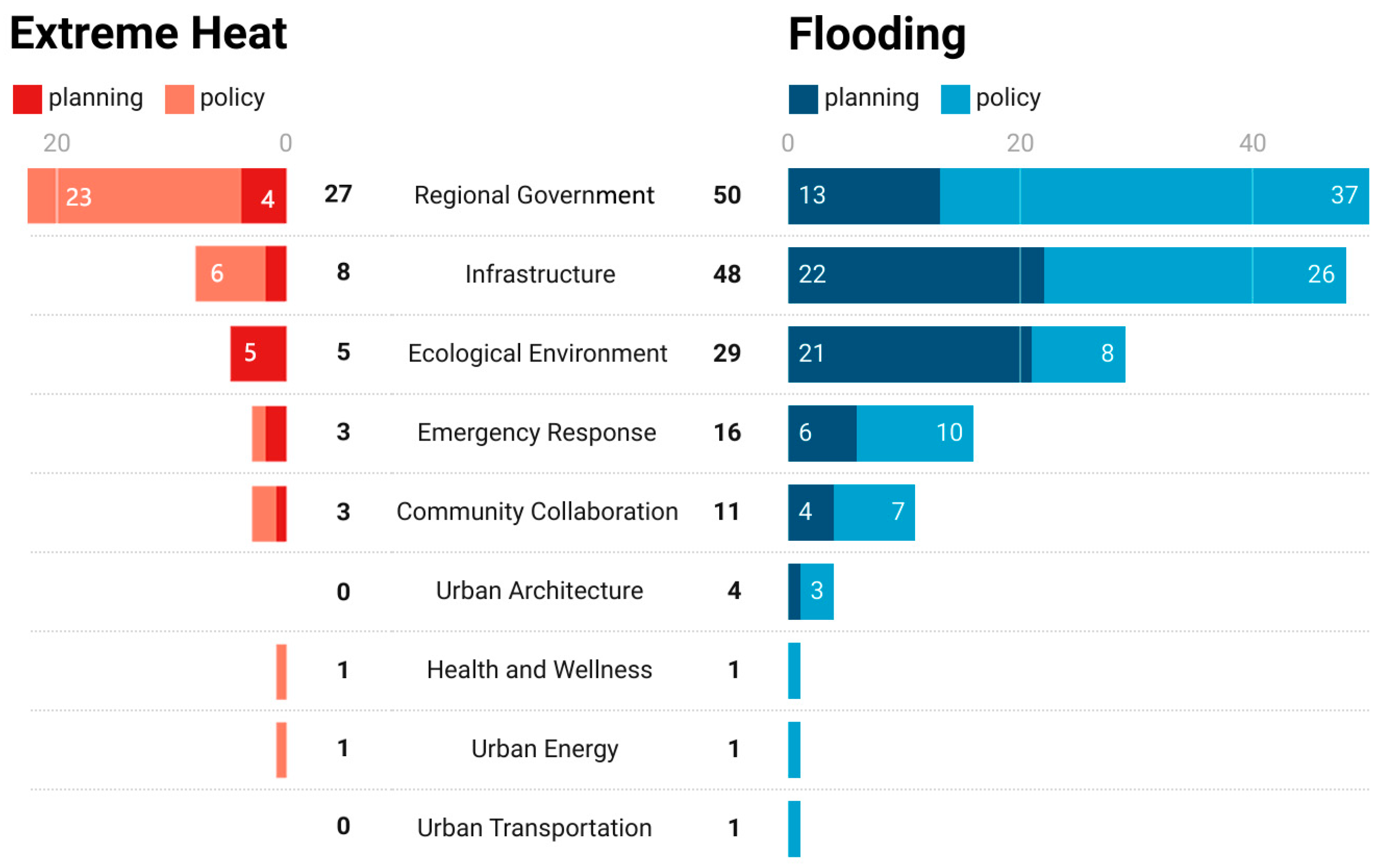
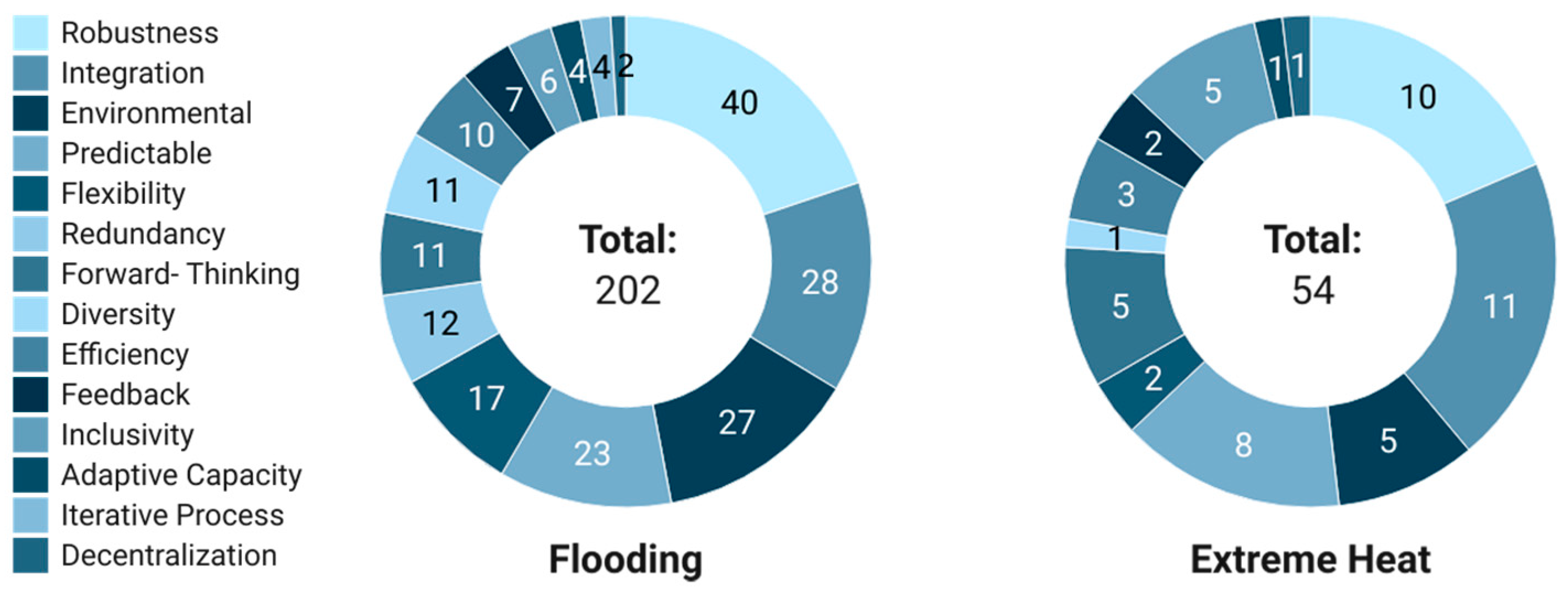
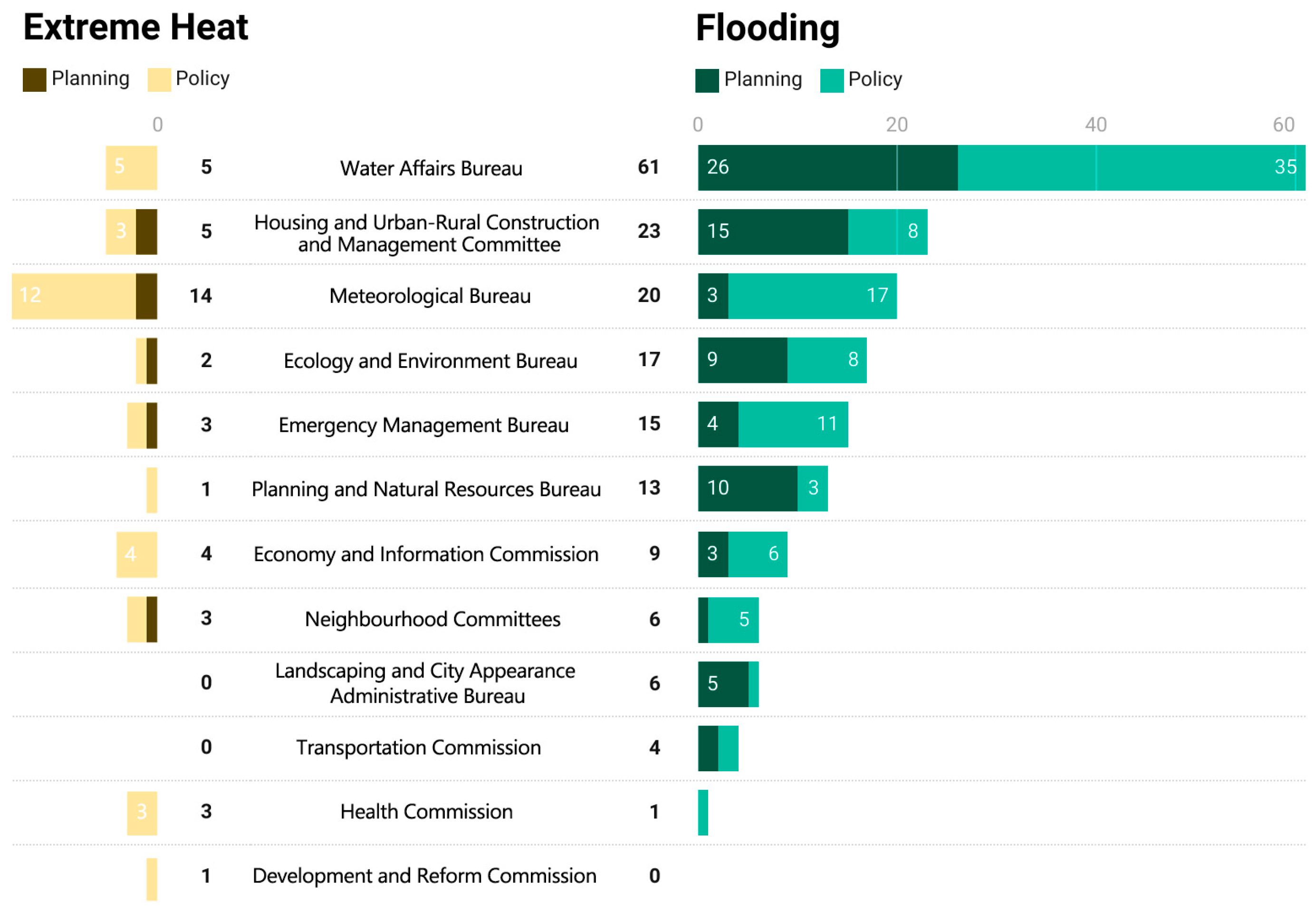
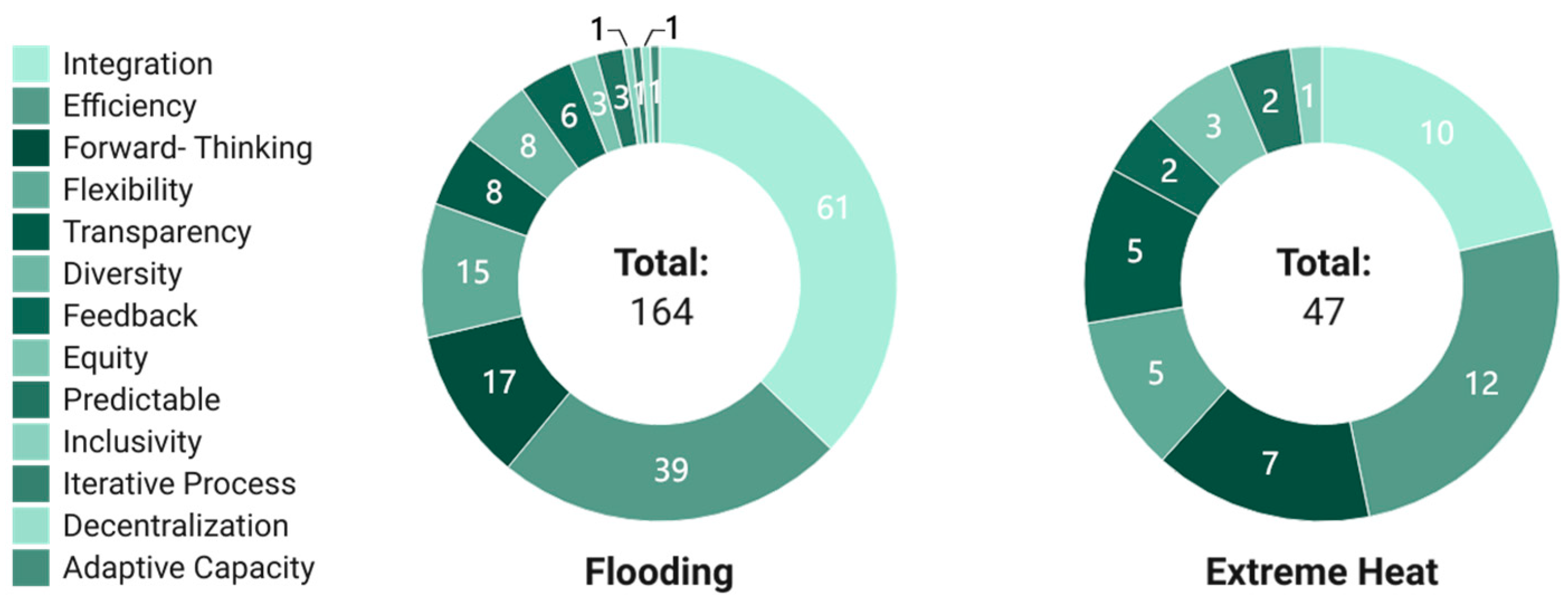
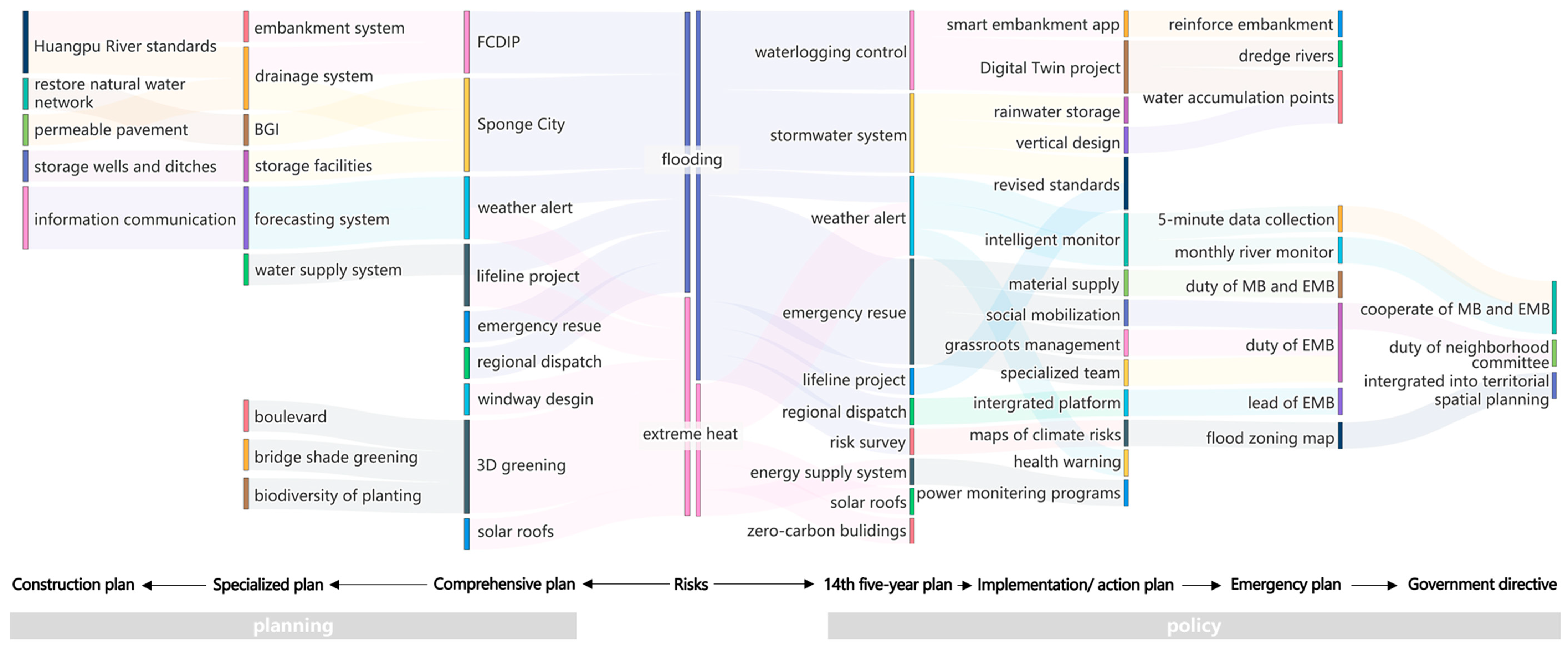
| Meteorological Elements/Climate Risk | 1993–2022 (30-Year) Average | Trend (/10 Years) | |
|---|---|---|---|
| average temperature (°C) | 17.4 | ↑0.415 | |
| annual precipitation (mm) | 1308.3 | ↑157.8 | |
| sea level height (mm) | 135.5 | ↑13.749 | |
| hurricane | days (d) | 3.0 | ↑0.932 |
| maximum single-day average wind speed (knots) | 27.4 | ↑0.012 | |
| storm | days (d) | 3.7 | ↑0.237 |
| maximum single-day precipitation (mm) | 101.6 | ↑16.274 | |
| extreme heat | days (d) | 19.0 | ↑7.244 |
| maximum temperature extremes (°C) | 37.7 | ↑0.568 | |
| extreme cold | days (d) | 26.4 | ↓3.317 |
| minimum temperature extremes (°C) | −4.8 | ↓0.099 | |
| Categories | Number | Interviewees | Field |
|---|---|---|---|
| Government officers | 4 | S1: Expert, the Meteorological Bureau | Meteorological Technology |
| S2: Officer, the Ecology and Environment Bureau | Environmental Protection | ||
| S3: Senior Officer, the Planning and Natural Resources Bureau | Urban Construction and Management | ||
| S4: Officer, the Emergency Management Bureau | Disaster Preparedness | ||
| Urban planners | 2 | S5: Planner, the Municipal Design Institute | Water Conservancy Engineering |
| S6: Senior Planner, the urban planning and design company | Urban Spatial Plan | ||
| Other stakeholders | 2 | S7: Urban Planning Professor, a local university | Academic Research |
| S8: Expert, the Urban and Transportation Development Institute | Resilience-related Study |
| Climate Disasters | Planning | Policy | |||||||
|---|---|---|---|---|---|---|---|---|---|
| Time | Causes | Codes | Comprehensive Plan (n = 2) | Specialized Plan (n = 7) | Construction Plan (n = 3) | 14th Five-Year Plan 1 (n = 6) | Implementation/ Action Plan (n = 5) | Emergency Plan (n = 1) | Government Directive (n = 1) |
| Acute | Meteorology | Typhoon | 1 | 1 | 0 | 2 | 4 | 0 | 1 |
| Rainstorm | 1 | 3 | 3 | 1 | 1 | 1 | 1 | ||
| Storm surge | 0 | 1 | 0 | 3 | 4 | 1 | 0 | ||
| Strong wind | 0 | 0 | 0 | 1 | 1 | 0 | 1 | ||
| Thunder | 0 | 0 | 0 | 1 | 0 | 0 | 1 | ||
| Hail | 0 | 0 | 0 | 0 | 0 | 0 | 1 | ||
| Temperature | Extreme Heat | 1 | 0 | 0 | 1 | 1 | 0 | 1 | |
| Extreme Cold | 1 | 0 | 0 | 1 | 1 | 0 | 1 | ||
| Heavy fog | 0 | 0 | 0 | 1 | 1 | 0 | 1 | ||
| Drought | 0 | 0 | 0 | 1 | 0 | 1 | 0 | ||
| Hydrology | Flooding | 2 | 7 | 3 | 4 | 5 | 1 | 1 | |
| Chronic | Sea-level rise | 1 | 0 | 0 | 0 | 1 | 0 | 0 | |
| Subsidence | 2 | 0 | 0 | 0 | 0 | 0 | 0 | ||
Disclaimer/Publisher’s Note: The statements, opinions and data contained in all publications are solely those of the individual author(s) and contributor(s) and not of MDPI and/or the editor(s). MDPI and/or the editor(s) disclaim responsibility for any injury to people or property resulting from any ideas, methods, instructions or products referred to in the content. |
© 2024 by the authors. Licensee MDPI, Basel, Switzerland. This article is an open access article distributed under the terms and conditions of the Creative Commons Attribution (CC BY) license (https://creativecommons.org/licenses/by/4.0/).
Share and Cite
Li, C.; Yang, H.; Yao, Q.; An, N.; Meng, H. Governing Urban Climate Resilience (UCR): Systems, Agents, and Institutions in Shanghai, China. Sustainability 2024, 16, 2648. https://doi.org/10.3390/su16072648
Li C, Yang H, Yao Q, An N, Meng H. Governing Urban Climate Resilience (UCR): Systems, Agents, and Institutions in Shanghai, China. Sustainability. 2024; 16(7):2648. https://doi.org/10.3390/su16072648
Chicago/Turabian StyleLi, Chun, Huihui Yang, Qiang Yao, Na An, and Haixing Meng. 2024. "Governing Urban Climate Resilience (UCR): Systems, Agents, and Institutions in Shanghai, China" Sustainability 16, no. 7: 2648. https://doi.org/10.3390/su16072648
APA StyleLi, C., Yang, H., Yao, Q., An, N., & Meng, H. (2024). Governing Urban Climate Resilience (UCR): Systems, Agents, and Institutions in Shanghai, China. Sustainability, 16(7), 2648. https://doi.org/10.3390/su16072648










